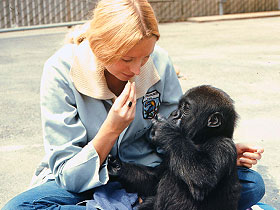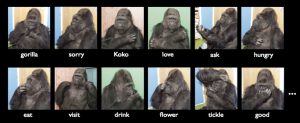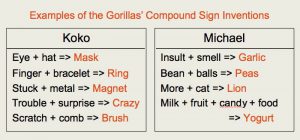Why Teach American Sign Language (ASL) to a Gorilla?
American Sign Language (ASL) was selected by Dr. Penny Patterson as the primary language to teach Koko because of the success that other researchers had with chimpanzees. It turned out to be a good choice, as Koko (and later Michael) learned it quickly. Within just a few weeks the gorillas were using sign combinations. Much later, observations by other researchers at zoos revealed that gorillas seem to have a natural gestural language of their own, using dozens of gestures consistently to communicate with one another (see ref. 2). This may explain why Koko and Michael learned ASL so quickly; it’s built on their intrinsic capabilities.
How Did Penny Teach Koko and Michael ASL?
Initially, Penny decided to teach 1-year-old Koko a few basic signs: FOOD, DRINK and MORE, by using a combination of molding and modeling the signs in context, as demonstrated here:


Another approach used was to have the caregivers sign to each other as well as to the gorillas whenever possible to reinforce learning by repeated observation. Additionally, Penny would always “speak” the words as she signed them. This would create another channel of parallel communication that reinforced the learning of signs (and also the learning spoken English, see below).
Gorilla Sign Language Acquisition
Koko learned sign language at a pace that paralleled language acquisition by human children. Her most rapid gains in new vocabulary occurred between years 2.5 and 4.5, as compared with human children who spike between 2 and 4 years. Koko learned over 200 new ASL signs in her 3rd year, and while her rate of learning tapered off (as it does for humans) she has continued to acquire new signs year after year, and her current vocabulary exceeds 1100 signs. Koko’s younger male companion, Michael, learned over 600 signs at a similar pace, and the two gorillas had the additional benefit of being able to improve their skills by communicating with each other.


In the above 2 charts, the yellow bars and curve (E Criterion) represent the number of signs emitted spontaineously and accurately at least once. The blue bars and curve (P Criterion) represent signs that were emitted at least half the days of a month and observed by 2 independent researchers. (See Chapter 10 of the book The Education of Koko)
Note that Koko learned to emit and understand over 800 new signs from ages 1 through 11, and went on after that to exceed 1000 signs. Michael, Koko’s original male gorilla companion, who was 2 year younger, learned sign language at a similar rate and developed a vocabulary of over 600 signs before his untimely death in the year 2000.
Gorillas Sign Vocabulary
Koko’s sign vocabulary ranges from the basics like: FOOD, DRINK and MORE, to emotional signs like: SAD, LOVE, GOOD, and SORRY to more sophisticated signs like: OBNOXIOUS, FAKE, and POLITE, and epithets like: STUPID DIRTY TOILET, and enable her to communicate about all aspects of her environment, as well as about more abstract concepts, memories, and stories that she either sees in books or on video.
While Koko’s sign vocabulary is larger than Michaels (roughly 1100 vs. 600), Michael was very articulate, using signs to convey complex stories about past events (see video below, Gorilla Michael’s [Bushmeat] Story).

Can Gorillas Understand Spoken English?
As Koko and Michael were learning American Sign Language, Dr. Patterson always spoke to the gorillas simultaneously while signing to them. Thus, both gorillas learned to comprehend a great deal of spoken English (over 2,000 words for Koko and a similar number for Michael). This is often surprising to people who first meet Koko, and think they can make private side comments to Penny; Koko usually keeps up with the conversation and responds accordingly.
Does Gorilla Sign Language Have Grammatical Structure?
People often ask if gorillas are really using sign symbolically or are mimicking individual signs to “get rewards”. Our research shows that gorillas Koko and Michael have used American Sign Language (ASL) in sophisticated ways, with sign phrase lengths of over 8 signs, and consistent grammatical structure. We have published some early papers on the subject and are now in the process of digitizing and analyzing four decades of data to shed more light on these linguistic questions. Our primary focus, however, is on cognitive questions such as: what can we learn about gorilla thought processes and emotions through two-way communication?
Sign Language Modifications and Modulations (GSL)
Gorillas Koko and Michael occasionally have modified the basic ASL signs they were taught for two reasons: 1) some ASL signs are either difficult or inconvenient for a gorilla because of differences in physical anatomy between gorillas and humans (e.g. gorillas have shorter thumbs relative to their index finger than humans), and 2) modulating a sign (e.g. making the gesture bigger or smaller, slower or faster, or in an unusual location) seems to be a natural way of expressing changes in emphasis, feeling, or differences in meaning. Human ASL signers modulate signs in similar ways, and understand most of the gorillas’ sign modifications. Nevertheless, all of Koko and Michael’s signs have been catalogued in multimedia formats with differences between Gorilla Sign Language (GSL) and conventional ASL noted and demonstrated.
Can Gorillas Invent New Signs?
Koko and Michael did not always know the sign for a word they heard spoken, or for an object or activity they wanted. In such cases, the gorillas would often invent a sign for the word by compounding two or more signs for words they already knew. For example, Koko compounded the sign for SCRATCH with the sign for COMB to mean, “brush” (SCRATCH-COMB). It wasn’t always obvious at first what the gorillas were trying to say. For example, it took a while for the caregivers to realize that when Koko placed the sign for the letter “s” at her “brow” she was making up a sign for “browse”, a word the caregivers often use for greens and flowers they gather for the gorillas as a snack.


